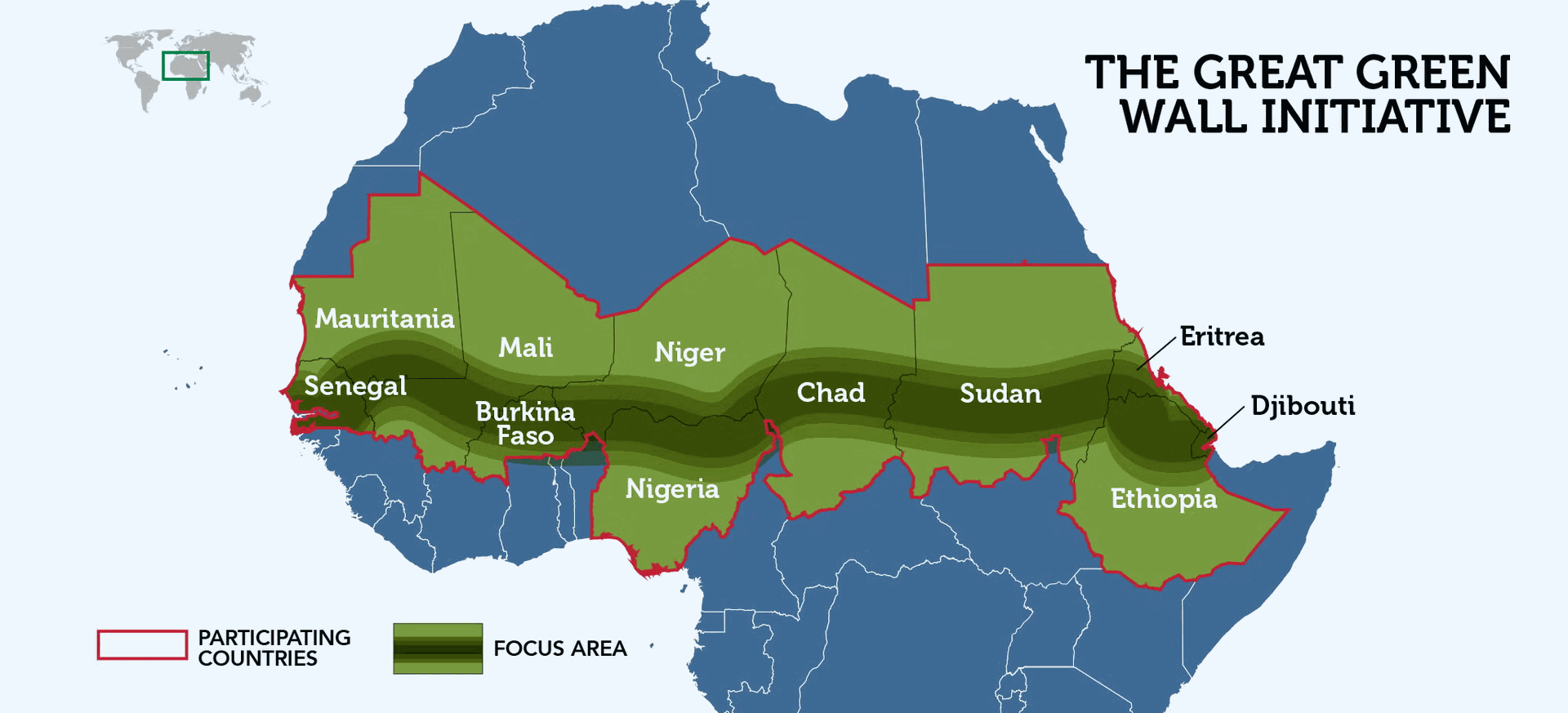In the dusty, drought-ridden Sahel region of Africa, a bold, pan-African movement is rewriting the narrative of land degradation, food insecurity, and forced migration. It’s called the Great Green Wall Initiative (GGWI), an African-led dream to regreen the continent and empower its people.

Spanning 11 countries from Senegal to Djibouti, the initiative aims to restore 100 million hectares of degraded land by 2030, sequester 250 million tonnes of carbon, and create 10 million green jobs. It is Africa’s response to climate change, ambitious, inclusive, and rooted in local ownership.
Started in 2007 under the African Union, the GGWI began as an idea to plant trees across the Sahel. But today, it has grown into a dynamic engine for sustainable development. It blends agroforestry, community-based land restoration, water harvesting, and youth employment across some of the continent’s most vulnerable ecosystems.
According to the UNCCD (United Nations Convention to Combat Desertification), nearly 20 million hectares have already been restored, with success stories emerging from Ethiopia, Niger, Chad, and Nigeria. Women-led cooperatives are leading reforestation projects, while young innovators are introducing tech to track soil health and plant survival rates.
Still, the project needs a major boost. Experts estimate that $33 billion is needed to fully realize the dream. Recent pledges from the African Development Bank, World Bank, and private sector partners have reignited momentum, but local governance and community participation remain key.
As the world debates climate finance and adaptation, Africa is already taking action, with its feet in the soil and its eyes on the future.
What Lies Ahead for the Great Green Wall Initiative
1. Environmental Restoration: By 2030, over 50 million hectares of land could be restored if current momentum and funding commitments are maintained or scaled.
- Why it matters: With 65% of Africa’s land degraded and desertification threatening livelihoods across the Sahel, restoring ecosystems can reverse biodiversity loss and improve rainfall patterns.
- AI/tech role: Drones, satellite mapping, and AI-driven soil analysis tools will improve efficiency and monitoring of reforestation progress.
2. Green Economy and Job Creation: The GGWI could generate up to 10 million new green jobs across agriculture, forestry, carbon trading, ecotourism, and renewable energy sectors by 2030.
- Youth dividend: With over 60% of Africa’s population under 25, GGWI will likely evolve into a youth-led green entrepreneurship engine, offering scalable employment solutions in underserved regions.
- Digital inclusion: Platforms that track tree-planting efforts and link workers to payments via mobile money will enable transparency and inclusion.
3. Carbon Market Participation: GGWI will position Africa as a key global player in the voluntary carbon credit market, generating $2–5 billion/year in revenue from carbon offsets by 2030.
- Countries like Ethiopia, Senegal, and Chad will likely lead the charge by formalizing community-based carbon tracking systems.
- Green Wall countries may partner with corporations seeking carbon neutrality—particularly in the EU and Asia.
4. Food Security and Climate Resilience: Restored land under GGWI could improve food security for over 100 million people by supporting regenerative agriculture and sustainable grazing.
- Enhanced soil fertility and tree-based farming systems (e.g. Faidherbia albida)
- This will reduce migration pressures and conflict over shrinking resources.
5. Pan-African Leadership in Climate Action: GGWI will become a symbol of African climate leadership and diplomacy, influencing COP decisions, climate finance mechanisms, and South-South partnerships.
- Countries involved will push for AfCFTA-linked green value chains, exporting sustainable goods, carbon credits, and expertise.
- Africa will reframe itself not as a victim of climate change, but as a solution provider.
The Great Green Wall is not a theory. It’s a movement. Village by village, seed by seed.